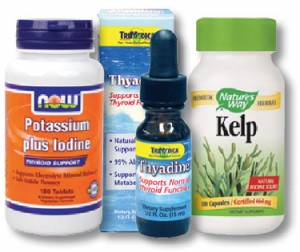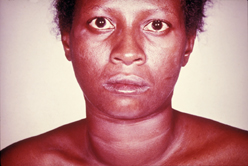5 Ways to Protect Yourself from Iodine Toxicity
 There’s no denying the fact that iodine has become a popular treatment method for hypothyroidism today. And rightfully so, considering that most websites discussing the topic of hypothyroidism bombard you with advertisements for the latest and greatest iodine supplements that are sure to cure your hypothyroidism.
There’s no denying the fact that iodine has become a popular treatment method for hypothyroidism today. And rightfully so, considering that most websites discussing the topic of hypothyroidism bombard you with advertisements for the latest and greatest iodine supplements that are sure to cure your hypothyroidism.
But have you ever stopped to question the safety or legitimacy behind saturating your body with unnatural amounts of iodine?
The popularity behind the use of iodine for hypothyroidism has been largely fueled by iodine’s use, centuries ago, in the treatment of goiters. This, along with other false beliefs regarding your body’s need for iodine, has led some practitioners to recommend that you saturate yourself with iodine, because of the ridiculous belief that more is always better.
Unfortunately, the only ones who win are those selling iodine supplements because the more you use, the more money they make.
Iodine toxicity is a bigger problem than most people realize. I recently discussed some of the specific dangers of iodine toxicity related directly to thyroid function in my blog post 3 Dangers of Iodine Therapy for Hypothyroidism.
How Much Iodine Are You Getting?
Of course, there is a lot of variation from person to person with respect to the amount of iodine people consume on average per day. There are certainly some people who are truly deficient in iodine although this is quite rare today.
Seeing as how the recommendation for iodine is currently 150 mcg per day, it should be easy to understand how one can effortlessly achieve the recommended amount.
Below are a list of some common foods and their iodine content which can give you a better idea of how much iodine you are getting in your diet:
Iodine Content in Foods
| ||
| Food |
Serving
|
Iodine
|
| Meat | 3 oz. | 15 mcg |
| Shellfish | 3 oz. | 21 – 37 mcg |
| Cod | 3 oz. | 99 mcg |
| Milk | 8 oz. | 58 – 116 mcg |
| Eggs | 1 large | 18 – 29 mcg |
| Potatoes | 1 medium | 60 mcg |
| Iodized Salt | ¼ tsp. | 115 mcg |
| Seaweed | 1 oz. | 18,000 mcg |
Getting enough iodine in your diet is oftentimes achievable in a single meal. A single serving of fish with a potato alone can provide you more than enough iodine in a single serving. This is without the inclusion of additional sources of iodine that most people are exposed to on a daily basis such as iodized salt.
How to Protect Yourself from Iodine Toxicity
Below are some simple guidelines to help you protect yourself from the negative effects of excess iodine.
1. Avoid Iodine Supplements
To give you an idea of the potency of many iodine supplements today, most people are using 12.5 mg to 100 mg of iodine daily, which equals 80 to 650 times the recommend daily allowance.
To put that into perspective, there are some studies that demonstrate the toxic effects of even a small excess of iodine, from as little as 1 mg.
If you suspect an iodine deficiency then it’s important to use proper testing to determine this prior to diagnosing yourself based solely on assumptions. Measuring your iodine intake as well as testing your urine to determine how much iodine is being excreted is one way to measure your potential for deficiency or toxicity.
Blindly taking iodine supplements puts you at a much greater risk of iodine toxicity which can further damage your thyroid and oftentimes contributes to the development of autoimmune thyroiditis.
2. Avoid Iodized Salt
 During the mid to late 1800’s iodized salt was beginning to be used to reduce the prevalence of goiters in many countries. During that time, iodine deficiency was a much bigger issue. But as you can see by simply looking at the table above, referencing the iodine content found in common foods today, iodine deficiency is not as common you as might think.
During the mid to late 1800’s iodized salt was beginning to be used to reduce the prevalence of goiters in many countries. During that time, iodine deficiency was a much bigger issue. But as you can see by simply looking at the table above, referencing the iodine content found in common foods today, iodine deficiency is not as common you as might think.
Seeing as how as little as ¼ tsp. of iodized salt provides almost your entire recommended daily allowance of iodine, it should be easy to see how the use of iodized salt can have quite the dramatic effect on your daily iodine intake.
It is also well known that hypothyroid sufferers lose sodium rapidly through their urine. Because of this, their need for salt (sodium) increases which only further compounds this problem and increases your risk of iodine toxicity.
Because of this, it is advisable to get your iodine from other dietary sources and to avoid iodized salt altogether.
3. Avoid Seaweed and Other Excessive Sources of Iodine
 The idea that seaweed, kelp, and other sea vegetables are rich in thyroid and therefore must be healthy for your thyroid has led many to label iodine-rich foods like seaweed as super-foods.
The idea that seaweed, kelp, and other sea vegetables are rich in thyroid and therefore must be healthy for your thyroid has led many to label iodine-rich foods like seaweed as super-foods.
But the extremely high iodine content can quickly become counter-production. Many types of seaweed provide as much as 4,500 mcg of iodine per ¼ oz., which is 30 times more than the recommended daily allowance.
4. Focus on Natural Foods that Contain Healthy Amounts of Iodine
The easiest way to avoid iodine toxicity is to simply focus on eating a naturally healthy diet that contains healthy amounts of iodine.
However, the topic of a truly healthy diet is quite complex as there are many other factors aside from iodine content that are important in overcoming hypothyroidism.
These dietary factors, along with a step by step plan on how to heal your thyroid, are discussed in detail in this Hypothyroidism Revolution Program.
5. Don’t Fall for Un-Scientific Testing
 Many practitioners who support using high doses of iodine for hypothyroidism also push various tests to determine your potential for iodine deficiency, most of which have been proven to be scientifically invalid.
Many practitioners who support using high doses of iodine for hypothyroidism also push various tests to determine your potential for iodine deficiency, most of which have been proven to be scientifically invalid.
One such unscientific test that has gained popularity is the iodine spot test. The claim is that you can tell if you are iodine deficient by painting a spot of iodine on your skin. If it disappears quickly then this is believed to be a sign of deficiency.
However, this test holds no scientific basis. Iodine can quickly be converted into colorless iodide through its interaction with many substances.
The bottom line is, avoiding iodine supplements, iodized salt, and other foods that are abnormally high in iodine is a necessary and important step in avoiding iodine toxicity and properly regulating thyroid function. Of course there is always the possibility that you could truly be iodine deficient and if you do suspect this, then do yourself a favor and get the proper testing you need to be properly diagnosed. Blindly taking an iodine supplement, or any other supplement for that matter, is an accident waiting to happen.





